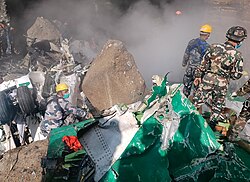Experts noted that the video from the ground taken moments before the crash showed the aircraft's nose noticeably high before the left wing suddenly dropped, probably indicating a stall. [37] Hours after the crash, a five-member committee headed by Nagendra Ghimire was set up to investigate the accident in conjunction with the French Bureau of Enquiry and Analysis for Civil Aviation Safety. [38]
Preliminary report
About a month later, on 13 February, a preliminary report was released, which largely reproduced all relevant logs.
(PF = Pilot Flying, PM = Pilot Monitoring): [42]
At 10:56:27, the PF disengaged the Autopilot System (AP) at an altitude of 721 feet (220 m) Above Ground Level (AGL). The PF then called for "FLAPS 30" at 10:56:32, and the PM replied, "Flaps 30 and descending". The flight data recorder (FDR) data did not record any flap surface movement at that time. Instead, the propeller rotation speed (Np) of both engines decreased simultaneously to less than 25% and the torque (Tq) started decreasing to 0%, which is consistent with both propellers going into the feathered condition [...]
The flight crew then carried out the "Before Landing Checklist" before starting the left turn onto the base leg. During that time, the power lever angle increased from 41% to 44%. At this point, the Np of both propellers was recorded as Non-Computed Data (NCD) in the FDR and the torque (Tq) of both engines was at 0%. When propellers are in feather, they are not producing thrust [...]
At 10:56:54, another click was heard, followed by the flaps surface movement to the 30 degrees position [...]
When ATC gave the clearance for landing at 10:57:07, the PF mentioned twice that there was no power coming from the engines. At 10:57:11, the power levers were advanced first to 62 degrees then to the maximum power position. At 10:57:20, the PM [...] repeated again that there was no power from the engines [...]
The aircraft's propellers had been feathered for about a minute before the crash, causing the engines to produce no thrust and leading the aircraft into a stall; the condition levers, which control the propellers, were found in the wreckage set to the feathered position. [43] [a] Seconds preceding the crash, the pilots discussed a total lack of power and even moved the power lever to the extreme but failed to recognize that the condition levers were incorrectly set. [42] Speculation at the time - eventually confirmed by the Final Report's finding of probable cause [1] : 68 - was that the Pilot Monitoring (Kamal KC) had inadvertently moved the condition levers in place of the flap lever when asked by the Pilot Flying. (Though differently shaped and operated, [1] : 45–47 the three are next to each other in an ATR 72.) When, about twenty seconds later, he set the flap lever properly on his own, he failed to account for his previous mistake, implying that the landing checklist was not properly followed. [43] [45]
Due to the shortened final approach leg of the visual approach for runway 12, this flight - like another three days earlier - failed to achieve the stabilization criteria, which are important for a safe landing, at the gate height of 500 feet (150 m) above ground level. This led the Aircraft Accident Investigation Commission to recommend the Civil Aviation Authority of Nepal (CAAN) conduct a comprehensive study for the determination of an appropriate flight path that allows a stabilized visual approach. [42]
On 15 March, the Government of Nepal extended by 45 days the deadline for the investigation commission's final report on the accident. [46]
Final report
On 28 December 2023, the final report was released. It reiterated the preliminary findings that the accidental change of position of both condition levers to the feathered position resulted in the loss of thrust, leading to the aerodynamic stall and crash. It found that neither airline nor regulator had approved the approach circuit chart being used, so that the recommendations of the regulator's Safety Risk Management team had not been put into effect. [1] : 69 Some other contributing factors were also found, mostly human errors due to a high workload, lack of appropriate technical and skill-based training, ineffective crew resource management (CRM), lack of sterile cockpit discipline, and non-compliance with standard operating procedures (SOP). [1] [47]



